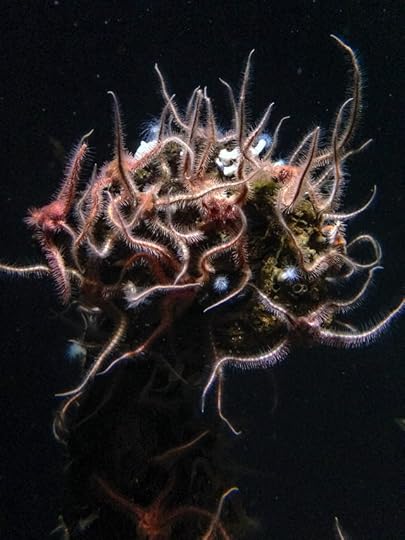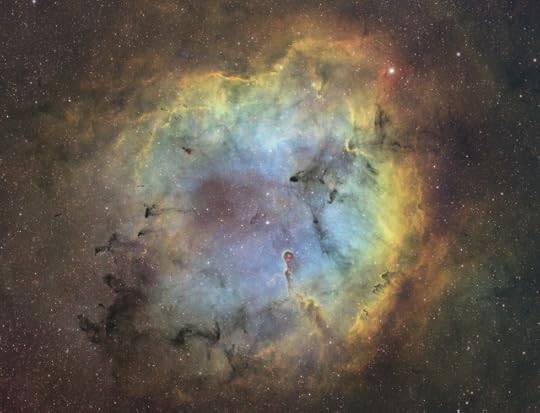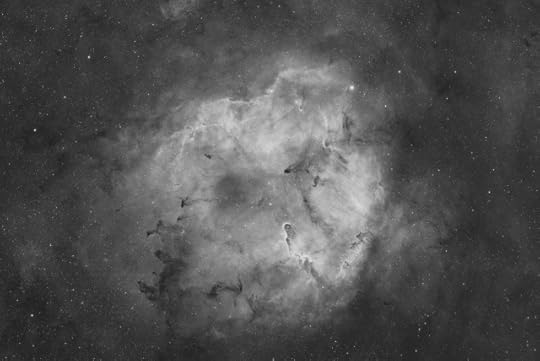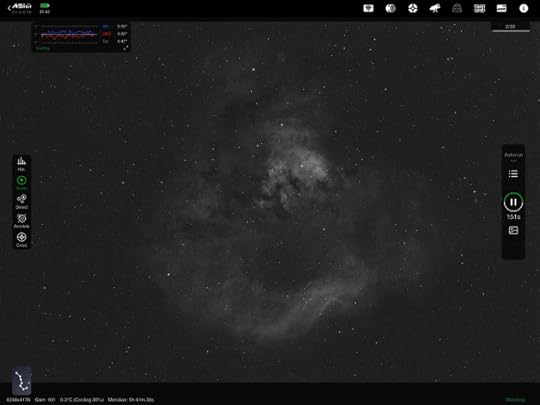Chris Howard's Blog, page 11
October 22, 2023
A beautiful cluster of spiny brittle stars (Ophiothrix spiculata?), shot with my iPhone on a trip to…

A beautiful cluster of spiny brittle stars (Ophiothrix spiculata?), shot with my iPhone on a trip to Monterey Bay Aquarium in 2013.
October 10, 2023
I spent most of the night capturing OIII (Oxygen 3) and SII (Sulfur 2) data in the IC1396 region in…

I spent most of the night capturing OIII (Oxygen 3) and SII (Sulfur 2) data in the IC1396 region in Cepheus, enough to combine with last week’s Ha (Hydrogen-alpha) data to create a SHO color image, mapping sulfur to red, hydrogen to green, and oxygen to blue in RGB. I’ve balanced the RGB intensity, but left green for Ha a bit higher. Hydrogen is the most abundant element in the universe—by a very wide margin, and without balancing the Ha, OIII, SII channel values, most nebulae would be overwhelmingly green. That said, I do like to keep more hydrogen green in my images, making them a bit truer to the emission values of most deep sky objects.
October 5, 2023
Cooper’s Hawk in the backyard, didn’t like me walking out with the Nikon D750, 300mm.

Cooper’s Hawk in the backyard, didn’t like me walking out with the Nikon D750, 300mm.
October 3, 2023
From last night’s narrowband imaging run: IC 1396 is a bright HII region over 2000 lightyears away…

From last night’s narrowband imaging run: IC 1396 is a bright HII region over 2000 lightyears away in Cepheus, illuminated and ionized by the very energetic multi-star system HD 206267 (that’s the brightest star in the center of the image). The massive star, top left-ish, is a red supergiant, “the Garnet Star”, μ Cephei (mu Cephei). Mu Cephei is almost 100,000 times brighter than our star, the Sun, and it’s over a 1000 times larger. Imaging notes: 61 x 300-second exposures stacked in PixInsight, minimal calibration, camera: #ZWO ASI2600MM-Pro cooled to -10C, Antlia 3nm Hydrogen-alpha filter. Even with an 80% waning moon, last night turned out well.
October 2, 2023
I setup the William Optics SpaceCat at lunch–beautiful day out there. We’ll have an 80% waning moon…

I setup the William Optics SpaceCat at lunch–beautiful day out there. We’ll have an 80% waning moon tonight, so not the best scenario for imaging, but I’ll make do. This will be the first time out with the 7-position filter wheel, which just looks massive on such a small refractor. I’m running with the 2-inch Antlia V-Series LRGB Pros and Antlia 3nm Pro narrowband filters. #ZWO #Antlia #astrophotography #astronomy #Sky-Watcher #WilliamOptics
September 20, 2023
Playing around with pixelmath in PixInsight with my narrowband data of NGC 7822, Cederblad 214, an…

Playing around with pixelmath in PixInsight with my narrowband data of NGC 7822, Cederblad 214, an emission nebula in Cepheus, about 3,000 lightyears away. This is Hydrogen-alpha (Ha) combined with Oxygen 3 (OIII) data I captured over several weeks, made up of 52 x 300-second exposures of Ha and 32 x 600-second (10 minute) exposures of OIII. Gear notes: #WilliamOptics Space Cat 51 (250mm FL @ f/4.9), #ZWO ASI2600MM-Pro monochrome camera cooled to -10C, Sky-Watcher EQ6-R Pro mount, William Optics 32mm/120mm FL guide scope + ZWO ASI290MM-Mini guide camera.
Target Notes: NGC 7822, Cederblad 214, SH2-171 (the brighter emission nebula core) as well as the star cluster Berkeley 59. There are several long chains and clumps of dark nebulae, including LDN 1268, 1275, Dob 3637, 3627, 3623, many more. Nestled in that large band of dark nebulae toward the bottom is the reflection nebula GN 23.56.1. The very small circle of gray at the top left, blending in but dimmer than the nearby stars, with less contrast, is the planetary nebula Abell 1 (PLN 119+6.1). Find all of this—the nebulae and star forming complex in Cepheus near the edge of Cassiopeia.
September 2, 2023
Our backyard groundhog, Suzy, is out and about today. She lives under the shed and is basically the…

Our backyard groundhog, Suzy, is out and about today. She lives under the shed and is basically the queen of the entire fenced-in area, a good half acre or so.
August 12, 2023
First Light with the ZWO ASI2600MM Pro mono camera
June and July consistently delivered terrible…

First Light with the ZWO ASI2600MM Pro mono camera
June and July consistently delivered terrible weather for astronomy. There was one clear-ish night somewhere in the middle of the waves of thunderstorms, torrential rain, and general cloudiness, but there was a nearly full moon, and a few hours of clear skies amid weeks of cloud wasn’t worth it. So I waited for the next opportunity. Last night, August 11th, I set up the Sky-Watcher mount with the William Optics SpaceCat and the new camera.
Here’s the result of my first imaging run with the ZWO ASI2600MM Pro mono camera, cooled to -10C, Antlia 3nm Hydrogen-alpha Pro Imaging filter (2 inch). 52 x 300-second sub-exposures with minimal calibration (bias & dark, no flat frames). The ASI2600 is built around the monochrome version of the Sony IMX571 APS-C sized sensor, and although you can get away with 36mm unmounted filters, I went all the way to 2 inch mounted narrowband filters. And not even a hint of vignetting. I didn’t use flat frames when stacking. So, am I impressed with the ZWO ASI2600MM Pro? Oh yeah.
I started narrowband imaging about ten years ago with Atik mono CCD cameras, moved through a couple QHYs, and settled on the ZWO ASI1600MM Pro—the smaller, older generation of this ASI2600. I’ve been using the 1600 for four or five years, and it was time to upgrade. The 2600 has been out for a little while—I’m not new to this camera but I’m really glad I made the jump.
Target Notes: NGC 7822, Cederblad 214, SH2-171 (the brighter emission nebula core) as well as the star cluster Berkeley 59. There are several long chains of clumps of dark nebulae, including LDN 1268, 1275, Dob 3637, 3627, 3623, many more. Nestled in that large band of dark nebulae toward the bottom is the reflection nebula GN 23.56.1. The very small circle of gray at the top left, blending in but dimmer than the nearby stars, with less contrast, is the planetary nebula Abell 1 (PLN 119+6.1). Find all of this—the nebulae and star forming complex in Cepheus near the edge of Cassiopeia.
Target Notes: NGC 7822, Cederblad 214, SH2-171 (the brighter emission nebula core) as well as the…

First Light with the ZWO ASI2600MM Pro mono camera
June and July consistently delivered terrible weather for astronomy. There was one clear-ish night somewhere in the middle of the waves of thunderstorms, torrential rain, and general cloudiness, but there was a nearly full moon, and a few hours of clear skies amid weeks of cloud wasn’t worth it. So I waited for the next opportunity. Last night, August 11th, I set up the Sky-Watcher mount with the William Optics SpaceCat and the new camera.
Here’s the result of my first imaging run with the ZWO ASI2600MM Pro mono camera, cooled to -10C, Antlia 3nm Hydrogen-alpha Pro Imaging filter (2 inch). 52 x 300-second sub-exposures with minimal calibration (bias & dark, no flat frames). The ASI2600 is built around the monochrome version of the Sony IMX571 APS-C sized sensor, and although you can get away with 36mm unmounted filters, I went all the way to 2 inch mounted narrowband filters. And not even a hint of vignetting. I didn’t use flat frames when stacking. So, am I impressed with the ZWO ASI2600MM Pro? Oh yeah.
I started narrowband imaging about ten years ago with Atik mono CCD cameras, moved through a couple QHYs, and settled on the ZWO ASI1600MM Pro—the smaller, older generation of this ASI2600. I’ve been using the 1600 for four or five years, and it was time to upgrade. The 2600 has been out for a little while—I’m not new to this camera but I’m really glad I made the jump.
Target Notes: NGC 7822, Cederblad 214, SH2-171 (the brighter emission nebula core) as well as the star cluster Berkeley 59. There are several long chains of clumps of dark nebulae, including LDN 1268, 1275, Dob 3637, 3627, 3623, many more. Nestled in that large band of dark nebulae toward the bottom is the reflection nebula GN 23.56.1. The very small circle of gray at the top left, blending in but dimmer than the nearby stars, with less contrast, is the planetary nebula Abell 1 (PLN 119+6.1). Find all of this—the nebulae and star forming complex in Cepheus near the edge of Cassiopeia.
August 11, 2023
First light with the new ZWO ASI2600MM Pro cooled monochrome camera, with a single 300-second sub of…

First light with the new ZWO ASI2600MM Pro cooled monochrome camera, with a single 300-second sub of NGC 7822, Cederblad 214, SH2-171 (the brighter emission nebula core) as well as the star cluster Berkeley 59. This is a screenshot of the ASIAir app running on my iPad.



